#the more i GM masks the more i want to play masks
Explore tagged Tumblr posts
Text

"I came to try and save you."
"You're doing a great job."
bit from the Halloween issue of the MASKS game I'm running. they were both dressed up as Ghostface but I didn't feel like drawing the mask even though it was the whole point!! the delinquent (westley) got buried in a coffin for a halloween game called Coffin King, but the jocks left him in there, then the nerd/doomed (adrian) went through a teleportation portal by accident and ended up trapped in the coffin with him, so we ended up with two ghostfaces in a coffin. BUT I DON'T WANNA DRAW THE GHOSTFACE MASKS!!
#masks: a new generation#masks a new generation#ttrpg#not my characters#westley#adrian#delinquent#doomed#one ghostface goes in two ghostfaces come out#there was also a werewolf#or rather an invisible man in a werewolf taxidermy suit#who wanted to skin some teenagers next#thumbs up#i'm sorry i didn't draw the masks!!! i wanted to draw their faces!!!!#masks: overlook city#masks: overlook#the more i GM masks the more i want to play masks#go play MASKS it's fun. the damage system is all emotional. it's great.
222 notes
·
View notes
Note
As someone who designs games, are there any specific games you've read that do interesting things with the Forged in the Dark or Powered By The Apocalypse systems that get you excited to write your own stuff?
(Asking those two since Protect the Child is FitD, also excited to hear if another system is excited rant worthy)
My friend, thank you so much for giving me space to ramble lovingly about games and mechanics. I don’t know if anything suggested here will be new exactly, but I am relishing the chance to talk about how the games I’ve read and played have impacted my design journey.
This is going to be a walk-through of various games that have given me a lot of tools to work with. Right now my head is full of Protect the Child, so I'm not really thinking about any other design projects, but I hope you enjoy this nonetheless!
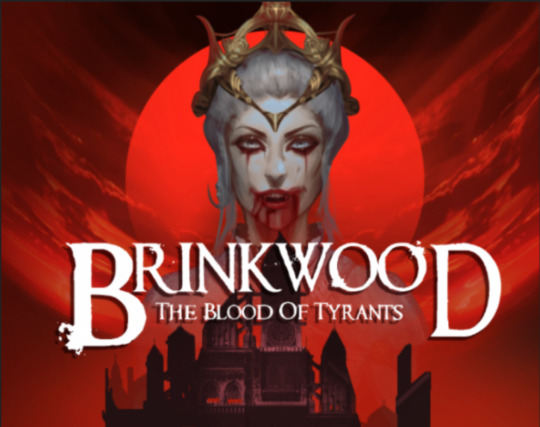
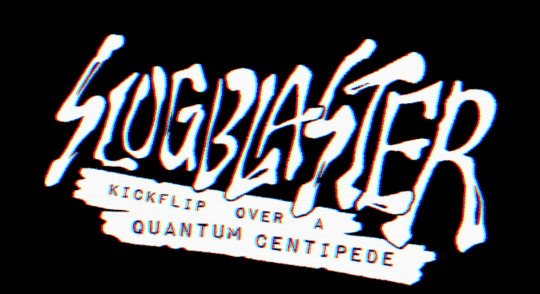

Brinkwood, by Far Horizons Co-Op, Slugblaster, by Wilkie’s Candy Lab, and Moth-Light, by Dissonance.
I knew of a few Forged in the Dark hacks before I heard about Brinkwood, but when I realized that the Masks were basically communal playbooks, my mind was blown. Both Slugblaster and Moth-Light appealed to me because of their setting, but when I read the rule-books I was also impressed by how they were able to take the base Forged in the Dark and change it to make the rules work for the proper genre and tone.
Brinkwood takes the playbooks with special powers and makes them communal. You can pick up a new set of powers every time but still play the same character, so you can have variety while still pursuing the same character’s storyline. Because the Masks are shared, the “crew playbook” doesn’t look the same as it does in a lot of other Blades hacks, as no matter what Masks you take, you’re still engaging in a rebellion against vampires. Brinkwood also gives the GM a lot of guidance on how to flavour the antagonists in a way that is challenging, interesting and dangerous, while also giving the players a way to veto any subject matter that bleeds too much into real-life boundaries. Honestly, I think Brinkwood probably directly influenced my game A Terrible Fate more than Protect the Child, but the initial moment of realizing how much you can play with the game was a really important step in my development.
Slugblaster re-organizes your dice resources as Boost & Kick, and shifts Stress into a currency (Trouble) that you have to spend, rather than a time bomb. This gives your characters more longevity and takes away a lot of the gritty trauma that works for Blades, but doesn’t make sense for hover-boarding teens. Additionally, Slugblaster gives agency of faction creation over to the players in a way that’s way more personalized than it is in Blades. Specific questions are meant to be answered by specific playbooks, which I think is a great way to speed up crew relationships, as well as ensuring that each player at the table has a piece of the world that they contribute to. When setting decisions are left up to the group as a nebulous whole, one player may have more say over setting creation just because they have the loudest voice or the most ideas. By giving specific choices to specific playbooks, you’re ensuring that each player has a piece of the world they can point to and claim as theirs.
Moth-Light takes the CATS safety tool and embeds it into Pact creation, allowing the genre and tone to shift the way the game is played slightly to reflect the kind of story the group wants to tell. The core setting is the same - a planet with gigantic bugs - but the ways the characters interact with the setting changes depending on the Pact that you choose. I think this is a genius way to give a group a way to use Safety Tools without them necessarily realizing it, and it ensure that the group enters the story on the same page. This mindset fuelled my choice to present the world-building as a series of questions for the players to answer, establishing some truths about the technology levels and the use of magic before players make their characters, setting some basic limitations to make sure folks are on the same page. Currently however, I don’t think I’ve achieved the seamless translation of CATS into a game-appropriate setting exercise - I’ve just ported CATS into the game.

External Containment Bureau, by Mythic Gazetteer.
External Containment Bureau minimizes a lot of their character options and does away with playbook options in order to make character creation customizable while still quick, and one of the primary ways they did this was by changing the way gear rules work in the game. In standard Blades, you can only use equipment to improve your Effect, but in ECB, you can use your equipment to add +1d or improve Effect. This is primarily because ECB doesn’t use stats in the way Blades does, but I liked the way that little tweak gave the player an additional resource.
Additionally, ECB doesn’t care about load. Instead, the character comes with some gear associated with their department, and a few gear slots that they can fill themselves. You can always have everything in your Gear section on you - the limitation is in what’s available. I really liked how the game provided a balance between gear that made sense for your department and gear that reflects the way the player wants to portray their character, so I did the same thing in Protect the Child.
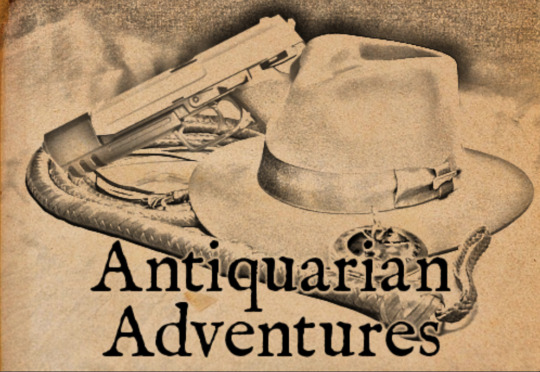
Antiquarian Adventures, by acegiak
I heard about the way Stress works in Antiquarian Adventures when I was listening to the Dice Exploder podcast, and it sparked a lot of thoughts about what Stress can be used for, especially since I knew that I didn’t want to give the characters Trauma in Protect the Child. Thematically, it doesn’t make sense to imply that parenting is inherently traumatic, and I don’t want to cast the Child as a source of trauma for the parents.
Antiquarian Adventures solves this problem by allowing Stress to re-set every time you fill it, as long as the player is able to dictate how the character suffers some kind of setback or brings about some form of trouble as a result of getting too stressed out. The exact trouble is attached to the playbook, adding to the distinct flavour of each trope. In Protect the Child, I made sure to add one Reaction that was unique to the playbook, to reflect the same kind of thing.
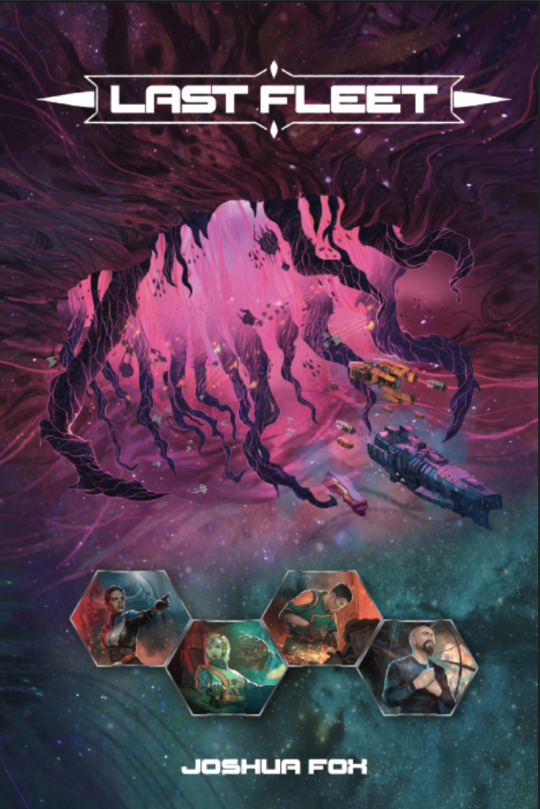

Last Fleet, by Black Armada Games.
Last Fleet blew me away with the Pressure mechanic. It’s a physical manifestation of stress that exists in the setting, that doubles as both a player resource and a ticking clock. You can spend Pressure to give yourself a better chance at success, but once it hits its cap, your character is forced into a situation that that they cause themselves.
In many ways, Last Fleet is doing something similar to Antiquarian Adventures, but the one thing it adds is that it gives the player options in terms of how they’ll cause trouble. Some options overlap across playbooks, but each playbook has a unique collection that helps keep it somewhat distinct from the others. One of the best moments I had in play was when one of my players realized that he had the option to actually turn on the group - the reaction was like a little present he’d just unwrapped for the entire group, and it made for an extremely memorable moment for the table.
Last Fleet also inspired me to shorten the Stress Clock in Protect the Child. Base Blades has a 8-mark Stress track, but in early play-tests, I felt like it was difficult for anyone to fill up their clock in a single session. The Last Fleet Pressure track can only hold 5 marks of Pressure, and re-setting it doesn’t empty the track, but rather puts it at 2. I think that constant Stress provides a bit of a friction point for players, which is needed since it’s easier for players to achieve bigger dice pools in Protect the Child.
Beam Saber, by Austin Ramsey
When I was agonizing about how to encourage more roleplay between players, someone recommended that I read through Girl By Moonlight. Unfortunately, I don’t own a copy of Girl by Moonlight. I do, however, own a copy of Beam Saber, so when I decided to comb through other Blades games for relationship mechanics, I stumbled on the relationship clocks of Beam Saber.
In Beam Saber, you write down beliefs you have of each other character in the party, and attach each belief to a slice on a Connection clock. During downtime, you have the option to Cut Loose, which helps two Pilots relieve stress with each-other at the same time as filling the Connection clock. Filling the clock awards XP as well as provides the characters an opportunity to confront each-other about the way they see each-other.
I liked the idea of using time together as a chance to relieve stress. As far as I understand, this moment of connection is also seen in Girl by Moonlight, but I decided to limit the amount of stress you could relieve in Protect the Child because I’m still operating under the ethos I was introduced to in Last Fleet - I want to keep the characters under a lot of pressure, making room for them to make terrible decisions, and therefore giving them room to grow.

Lady Blackbird, by John Harper.
I returned to Lady Blackbird when I realized that the way I’ve set up runs in PtC means that it may be hard for players to do things like engage in long-term projects, or train for XP in a regular Downtime session. I also noticed that it was hard to get the players to roleplay with each-other with the way that Downtime is written in base Blades - it’s often navigated through in a very procedural way. Finally, I wanted to make the game a bit more one-shot friendly, with a way to present a Downtime-like section partway through the game without bogging down play too much.
Lady Blackbird has moments in between Action scenes where it explicitly encourages players to engage in flashbacks or character interactions in ways that allow them to clear conditions and provide a bit of exposition into their backstory. This, coupled with the Impressions in Beam Saber, gave me the tools to both encourage the players to role-play while also giving them the tools to foster relationships with each-other.
Right now, Rest Stops only have two moves: Bond with the Child and Bond with Each-Other. By reducing both of your options to moments where your character interacts with other characters, and encouraging both of these options to reflect your character’s ideals and history, I’m hoping to provide some of the maintenance of Downtime while encouraging the role-play that happens in Lady Blackbird. Longer downtime actions are relegated to Time Passes, which will only come up in campaign play.
I still haven’t perfected this stage though. For example, I haven’t figured out what to do about wounds.

Apocalypse Keys, by Rae Nedjadi / @temporalhiccup.
It’s kind of hard to quantify or describe the influence Apocalypse Keys had on my design, but I’ll give it a shot.
In Apocalypse Keys, your character never has to fail. There’s always options to give yourself a success, it’s just a question of how much you want to sacrifice parts of who your character is in order to get what you want. Apocalypse Keys is itself an amalgamation of a number of different mechanics from various places, such as the way you use tokens to improve your rolls, as originally found in Libretè, or the Theorize roll, popularized in Brindlewood Bay but originating in Codex: Moonlight.
The character playbooks are also centred on different struggles that the player has decided to wrestle with. The Summoned has a lot of moments centred on fighting destiny, while the Last wrestles with grief and loss. Some of the themes in these playbooks give you a lot of freedom to explore struggles and traumas that affect people in real life, but are flavoured in a way to give your monsters great power and extremely interesting backstories.
Finally, the way your character looks is completely up to you, and is irrelevant to the things your character can do. If you want a thousand glowing eyes, it doesn’t matter which playbook you choose. If you want to be the spirit of all werewolves that came before you, it doesn’t matter which playbook you choose. If you want to carry a golden spear that can listen to the regrets of the restless dead, I don’t think it matters what playbook you choose. I think that there’s a bit of a carryover from what I love about Changeling: the Lost to be found in Apocalypse Keys, in that your character’s origin and presentation can be as varied as whatever you can imagine, and can fit into the themes of whatever playbook you decide to wrestle with.
Protect the Child doesn’t directly borrow any mechanics from Apocalypse Keys, but I think the ethos behind the design is there. I want the players to experience the same creative freedom, while tying down specific themes to specific playbooks. I want to enable conversations about real issues that affect real people, while allowing the table to situate those issues in whatever setting makes the most sense for the group. I want the players to feel powerful, and at the same time recognize that the biggest obstacles to being good parent are generally incredibly personal.
I also admire the way that Nedjadi designs, from the rigorous play testing, to the purposeful openness about his inspirations, to his careful documentation of who has inspired him and where his ideas came from. I think being able to provide a clear through-line to the ways your were influenced by other design works is good for the historians of our hobby, and it also reinforces a culture in which game designers influence and allow themselves to be influenced by each-other.
166 notes
·
View notes
Text

Superhero B-Plots
I really dig secondary superhero stories- plots which don’t involve investigations, powering up, and titanic clashes. I dig the domestic stories, explorations of backgrounds, and looks at weird daily life. Some storygames offer a great toolkit for this kind of play. I’m thinking of Masks: A New Generation especially here. But if you’re running a more trad supers game or even if you just want some small inspiration, I’ve put together a toolkit for you.
This list presents a tool for creating superhero secondary stories and hooks for play between missions, battles, and capers. It is useful for GMs and players of ttrpgs like Mutants & Masterminds, Hit the Streets, and Wild Talents. It has 180 prompts, broken into three categories:
Friends & Family: Problems and entanglements for NPCs in a player character's circle. Each is written loosely enough to be adaptable to all kinds of characters.
Personal Life: Things which happen in the day-to-day life of the PCs. These can be tweaked depending on if the character has a public identity or a daily grind job.
Superhero-Dom: Events connected to their time and experience as a hero.
These prompts can be used by the GM to generate new plots and events, or players can draw an select from a story idea which appeals to them. Ideally one or two players each week can have a B-Plot which may or may not get resolved that session. It's a great device for covering downtime.
91 notes
·
View notes
Note
humbly asking you for more info on leo ortiz (if you want to ofc!) because everything i hear about him makes me fall more in love
Humbly (but elaborately) answering!!! I love my son - the fact that i advertised for his death to my GM non-withstanding, ignore that.
Leo Ortiz aka Starbright was my character in a game of Masks: A New Generation that is run by my dear friend @vin-ill. (he doesn't post all that much on here but he's a creative genius and I stand by that as his friend, dm, and player).
For those unfamiliar, Masks is a ttrpg based on the 'Powered by the Apocalypse System' (pbta for short). The main draw is that you play a teenage superhero. You are figuring out who you are, who you want to be, and what others (adults especially) want you to be - and whether you want that too.
the TL;DR about Leo is that he's a hypocrite, he never wanted to be a hero, is deeply self-sacrificing, kind of aloof and a dick but cares so much. And that he loves his brother despite everything.
If you want to long version on Leo's history, then take a peek below.
Leonardo Nathaniel Osborn aka Bryce Brilliant started out as the 'Star' playbook. Playbooks aren't like dnd classes, the idea is that you play an archetype. In this case the concept of the Star was being a Hero Influencer, who has an adoring fanbase.... but also obligations that come with that.

(above is the first page of the star playbook I had customised with my own art of Leo :D)
Before being a hero, Leo was a child-actor. When he came out of a car accident with light based powers, his mother created the hero persona 'Bryce Brilliant'. She was his manager and being a hero was just another role he played. His half-brother Logan (older) had been jealous and spiteful of this, he wanted powers, he wanted to be a hero.
When teaming up with a couple of other kids to save the day, his mother insisted they become a superhero team (aka the other players). Their team name was the Bryce Brilliants. They even had a Shoe brand sponsorship.

(first drawing of the entire squad, from left to right: Sam aka Saber, Leo aka Bryce Brilliant, Carey aka Carry, Sky Lee aka Justice)
In the team Leo first learned how to have proper friends teammates, and see being a hero as more than another role to play. Eventually he met Johanna Ortiz, the women he got his powers from.... What you thought they awakened naturally? No his mother bought these powers, she owns the Brilliant name, she owns the right to these powers. Powers that were grafted onto her son.
This is the moment Leo changed playbooks from the Star to the Protege.
The Protege playbook gives the player an NPC who is their mentor, they have a label they embody, and that they deny. (labels are like stats, but they are constantly shifting and are about how you see yourself vs how others see you). If you wanted to play a Robin type character you would probably pick the Protege. This is when he took on the superhero name Starbright.

(above is a screenshot of the Protege mentor labels, to give you an idea)
Leo moved out of his mother's home mansion, and moved into Johanna's trailer. It was quite the culture shock for the boy who would've unironically have said; "I mean it's one banana michael, what could it cost? ten dollars?".
He didn't get to stay a protege for long, as only a few session after he got uhhhhhhhhhhhhhhhhhhhh. Posessed.
Long story.
TL;DR: power dampening crystal was ground up and put into the water supply. Mixed with an entity that my GM called a 'Hydra-nt' (hydra creature made of water). So it became somewhat sentient and started serious shit all across the city. I failed a roll so fucking bad my guy got possessed by said goo and booked it into the direction of the Gotham to our Metropolis.
The team finished saving the city before going to the Worst City Imagineable(tm) to stage a Leo themed rescue. I played a character named Dr Lovelace (phd) aka Deckard Lovelace at this time, he was a child genius and earned his PHD when he was like, 12 or smth. He had mechanical limbs. i luv him. He never quite got into a hero persona but i had the name Dr Gizmo ready for him. He was the Brain playbook.


(some out of context memes from said rescue mission i found looking for smth else. David is me btw, hi.)
The team found Leo, he got exorcised with the power of friendship and this gun i found. (yk i dont remember exactly what happened, i think Carry did smth fucky with some uhhh power dust she had recently accidentally snorted which was absolutely not Deckard's fault. don't look at me)
the TL;DR of all that is that Leo was possessed by something that was aligned to one of the Five Powers That Be in this universe. Specifically he was possessed by the embodiment of the Abyss, emptiness. We ruled that going from Nothing to once again Everything that Leo was before changed his powers (and him) fundamentally. From then on Leo was the Nova, playbook. (also I made a tiktok about Leo not actually being dead at the time - wow did that not age well. not because it sucks, i still think its funny, but because he is kinda dead now)
The Nova playbook is build around the concept of having amazing godly powers, but little control. You could do everything and anything, but at what cost? Leo's powers become more cosmic than simply light based as a result. (smth smth becoming the sun itself, instead of the light it sheds)

(also HI obligatory new superhero outfit after life changing events 💛💛💛. The jacket used to belong to Johanna 💛💛💛)
A bunch of stuff happened after they got back. Leo changed his name from 'Leonardo Nathaniel Osborn' to 'Leo Ortiz', to officially move away from his birth-mom and align himself with his adoptive one. He broke into prison a little bit to talk and start the healing process with his brother Logan (oh yeah forgot to mention Logan was briefly a villain and Leo got him send to prison). Met a new teammate (an old player returning with a new character). Somehow kept collecting and aligning himself with the OTHER 5 powers that be, which I wasn't even actively trying for yknow. And yknow, fought a religious organisation for a bit.
One that Deckard is totally not responsible for gaining power, nooooo.... Don't look at me. (he just gave their leader a back of magical power dust in exchange for getting information on Leo during the rescue mission ok. it's fine, literally....)
At the climax of that arc, said leader tried to achieve godhood. And using the Nova's 'Moment of Truth', Leo took all of said power inside himself. Completing the 'powers that be' collection in the process, and shooting up far into space where he's become this kind of... shining star.

The moment of truth is an un-lockable playbook feature, where the player takes brief control of the narrative using the guidance of a written out blurb on the playbook. The above image is the MoT for the Nova playbook.
In his death he has created a new power in the universe - the power of friendship. No im not fucking kidding. The list is now: Potential, Tempest, Abyss, Sublime, Architects, and Leo with the power of friendship (and this gun i found).
Figuring he was too volatile to survive very long, he wrote letters to important people in his life. Letters I actually wrote out and printed, and were handed out during play to Players and NPC alike. They were read aloud and it was all very emotional, tears were shed.
A small excerpt from my favorite letter, written for Leo's brother:
Hi Logan, I love you. We stopped saying that to each other at some point. I can’t recall exactly when, I just knew you stopped saying it back so I did too. You know my friend Fleur? Her mother was pretty fucking bad too, and her older brother took her and ran one day. Sometimes I wish either of us had the courage to do the same when we were kids. I’m glad we kind of got there in the end. I’m sorry we lost so much time. I'm sorry we won’t have any more. (the letter continues here but its too long for this already long post)
Leo holds a very very special place in my heart. And he's like, super fucking dead now, and I wanted that to happen. Biting myself for that, evil bastard who does that to a character ಥ_ಥ.
If you got this far, thank you for reading! I love you 💛💛
#masks a new generation#masks#idle chatter#oc: leo ortiz / starbright#this got sooooooooo long and im not sorry gamers
27 notes
·
View notes
Note
having thoughts about your point that players/the gm shouldn’t have to design anything for a good ttrpg and wondering if i’m thinking of the gm’s role using inaccurate terms. what would you call the gm’s responses to uncertain mechanical situations in a given game (e.g. a mixed success in pbta - the onus is on the gm to come up with what that means, following some guidance from the rules.)
it seems like something that people find comforting about d&d is that even though the rules are overly complex (and often confusing), many of the common mechanics have clearcut (and boring) outcomes (such as save or suck, hit or miss, etc), meaning the gm doesn’t have to produce/interpret a result themselves. is the other approach (i.e. rules-light) putting more “design” weight on the gm? or is that thinking of it too formally?
otherwise, good design being the gm’s responsibility seems like it just falls under the umbrella of playing in good faith - whatever the situation, it’s bad faith to create untenable/insoluble scenarios that the players can’t meaningfully navigate
yeah, i mean--PBtA games have a list of GM moves, right? when a player has a mixed success, usually that means they succeed and the GM makes a GM move. and obviously those moves have choices and stuff the GM needs to come up with -- something like Monster of the Week's "Put someone in trouble" or "Separate them" definitely require the GM to think of how that works in the fiction -- but that isn't game design, right? the mechanical aspect of that has been handled by the game's rules text. so i think that if there's more weight on the GM i think it's strictly creative weight rather than design weight, unlike the 5e GM who is forced to mechanize anything they might want to make up and is often left without any mechanical guidance
and i mean, i think in general 5e (and dnd more broadly) give the GM absolutely fucking nothing to work with. there are literally no GM-facing mechanical levels other than enemy statblocks (which also, unlike something like Lancer or even fucking 4th Edition, come with no guidance on how to use them or how to assemble combat encounters with them). it's much, much easier to GM a game with GM moves, because then you have an actual set of mechanical levers available to you--and of course, like the aforementioned "Separate them", these levers automatically lend themselves to telling the sort of stories the game advertise for their genre. here's some GM moves from other PBtA systems that, just by seeing them as a mechanical lever, can push the story into the genre and tone directions the game wants to emulate:
Put innocents in danger (Masks, teenage superhero drama)
Reveal an unwelcome truth (Fellowship, high fantasy adventure)
Make honour and shame real (Sagas of the Icelanders, saga-era viking drama)
Bring their gender into it (Night Witches, Soviet airwomen war story)
Make them teach a class (Pigsmoke, magic-school cutthroat academia)
and one of the absolute best things about GM moves (and similar mechanics, like BitD's consequences, or BOB's setting sheet moves) is that because they are clearly delineated and restricted, there's no self-policing. because a dnd 5th edition DM can, rules as written, say at any point "100 ogres appear and beat you to death", they always have to be navigating a series of unspoken social contracts, creating threats but never threats which can win, introducing problems and consequences at a rate that keeps stakes up but is also fundamentally winnable, make everythign feel 'fair'. and dnd players have learned to accept this all as just the table stakes of a GM role, but it doesn't have to be. because all that is game design, and in a better game, that design is taken care of. GM moves say 'look, we've already thought about pacing and fairness, here's the levers we've pre-designed for you to pull, go nuts and tell a story with them'.
so in my opinion PBtA mixed successes represent a lot less onus on the GM to design the game for the designers than anything that happens in 5th edition outside of individual clearly resolvable combat actions--and it's one of the reasons i started having much more fun with TTRPGs once i stopped GMing 5e and realized that other games gave me actual tools and support to work with instead of expecting me to do all that bull shit
191 notes
·
View notes
Note
Aita for never making white ttrpg characters?
Title is a little weird, but I play a lot of ttrpgs with friends. I (M19) am white, so is all but one girl in our ttrpg group (F23), she’s Puerto Rican.
Anyways, all the games we play are rpgs based in the real world, whether they be urban fantasy or horror, they’re never in fantasy worlds. I like to explore different cultures, researching them and designing accurate characters for these games. I made a Bangladeshi girl for a MASKS: New Generations game who wanted to be the first desi superhero in America and was attending a superhero boarding school in upstate New York, I made half Iraqi/half Black boy in a homebrew power by the apocalypse game who was raised by his Chinese step-mother and was adopted into a giant extended family that took place in Brooklyn NYC, I made a black camp counselor for a Sleepaway oneshot, and I made a Mexican/Cajun boy for a Monsterhearts game taking place in south Louisiana.
For every character, I took my time and did days of research into backgrounds, cultures, and potential sensitivity issues. The last thing I want is to misrepresent a culture. The Puerto Rican girl in our group, let’s call her “Mary”, has never had a problem with my characters, but I’ve gotten comments from other players that it’s weird that I never play any white characters. I’ve made a white character twice; one for a Ten Candles game who was a 50 year old vet (and I miss him everyday, easily one of my favorite one-off characters because of his intense hatred of the Dallas Cowboys), and one for a homebrew 80’s slasher game who somehow because the first jock to be a final girl (He was too pure for this world, can’t wait to play his reincarnation in an ALENS game)
Our forever GM hasn’t ever had an issue with my characters, she even brings a giant variety of NPCs from all over to her games and makes the whole experience so much fun. The few times she’s made characters, they’ve always had great chemistry with mine and I’ve always had a good time
But, even with Mary’s and the GM’s approval, I still feel off about the comments of the other players. I love my characters, and the research I do for them helps me as a writer as that’s my profession atm. It seems like every time I propose a new character who isn’t white, I get asked “so what part of the world are they from now?” or “aren’t you German? Are you scared of doing a German character?” or other questions like that
I don’t play ttrpgs to insert myself into different fantasies, I play ttrpgs to explore new characters and new settings through different experiences. I don’t want to be labeled racist, but I understand if I’m coming off that way. If I’m voted the asshole, I’ll reflect and learn why. Commenters, deffo tell me how I can be better.
Anyways, AITA?
TL:DR, I’m white, I make primarily POC characters in ttrpgs, my group is annoyed and makes passive aggressive comments each time I do so. Aita for not making more white characters?
🔮
to find this later ^^^
What are these acronyms?
103 notes
·
View notes
Note
In VGM 0 you briefly talked about a reveal you did as a GM in a different campaign where you walked through a door before the discussion moved on to something else, if you want could you tell us more about that? I hope you have a nice day :)
yeah this was in a long running masks campaign, it started as a super hero school game (Nedo Institute) j did every plot I could think of, classes, to house parties, to superhero interns to prom.
Eventually the school was stolen from its dimension and was placed in a universal gateway type plane, u know the one
So I have the players exploring different parallel worlds and different universes and after a while I have them go to one, where I basically just described my neighborhood, they had a radar that detected anomalies and I had them make their way to my at the time apartment and into the actual closet I was using to record at the time and had me the gm playing myself, in my computer, in a discord call taking to their players.
Then I explained to them who I was and what they were and that they had to kill me to go home (in hindsight, ya girl was struggling with alot of depression this was about 3 years before I started transitioning)
Like I said I was doing any and all comic book plots I could think of and I had just read animal man.
If I remember the reception was mixed some players liked it others hated it and told me never to do anything like that again
That's the story
9 notes
·
View notes
Note
Hi! 10kDays has had a vice grip on my psyche for the last week or so, and I'm really excited to play the preview. However, I don't wanna make anyone else in my group GM this game just because I want to play it, so I'd like to try out the GMless mode of play, and so would they, but none of us have any experience with that style of game.
Is there any game you'd recommend we look at for a general picture of how you intend GMless play to work? I do own Ironsworn, which has a GMless mode, so if that jives with what you're intending that would be really convenient lmao.
Thanks for your time!
So there's a couple of thoughts i have here, starting with the shape of the game and the pieces of it that need different kinds and amounts of attention:
The game itself is kind of designed in three strands: courses, combat, and the Face game.
Courses are an adaptation of the Arc/quest mechanic from Jenna Moran's Glitch. I've found that they reduce the GM load hugely, for two reasons: you can roll up half an hour before game, ask "who wants to be in the spotlight, what does your quest say is happening in your life right now, and what needs to happen?", and drop something in. Connections and debts are also designed to give you improv prompts, and to a slightly lesser extent perspectives. The other benefit of Courses is that they move planning burden from "GM, night before game" to "player, whenever they want to think about their blorbo". So on a large-scale, "figure out what the campaign looks like" view, you can get away with improvising every session and just following your own character arcs. Likewise, the District moves and intentions are intended to give GMs an easy "i don't know what to do next" button, and the focuses of mask/gear/bell are intended to share around the responsibilities of worldbuilding. Ironsworn's oracles are another example of how to help outsource some of that decision-making, and it's the reason Appendix Yi is earmarked to be a million random tables. For more information on how oracles work, please google Jay Dragon's Sleepaway on your work computer (or at least read this Twitter thread from NightlingBug).
There are a couple story structures that are well suited to wuxia and this game. There's the Shaolin Soccer/shadowrunner/classic ttrpg setup where you are clearly a team, and there are enemy teams, and you are doing hijinks against them. But there's also a Jin Yong wuxia epic type thing where you have, let's say three or four PCs, and you're maybe nominally on the same side but you're clashing a lot and you're tied together by sworn and blood kinship and you keep running into each other. I think the most pared-down version of 10kdays you could run and still call it a full game is 3 players, characters living sort of far apart so they rarely run into each other, and interactions are 2 of the PCs clashing at a time while the 3rd player picks up any NPCs, throws in some District moves, etc. You could do a 2-player game but the kinds of interactions you could have would be severely limited, I think. The Face game of politicking and building support structures is kind of just... you two, face to face.
Now the problem on everyone's mind is fighting. It's attention-intensive, everyone's interested in it, and depending on your setup there can be loads of combatants that a GM would normally be expected to pilot. Again, there are a couple of scaffolds for trying to do this GMless. The sample Techniques in Appendix Jia come with combat tactics to make use of them, so any player can pick up an NPC combatant and figure out what they're going to do. Fight choreographing like this runs the pitfall of it feeling sort of bad to hurt your friends effectively, at least for some tables, but there is the incentive of hitting your friend's Bite highlight when you grab the corpo thug and bite them in the ass.
It is one of my mid-to-low priorities to create like algorithm type protocols for enemy fighters to run themselves, though that's still in the pipe dream phase. One thing I'm looking at here is Katabasis by Rathayibacter, which has a super cool system for easily lining up combatant actions, enemy or not). Maybe I'll end up with literal combat loop Turing machines or something.
There's one more option here which is to lean the other way -- to foreground the GM themselves being a player. I'm talking Ryuutama dragons, I'm talking Fellowship Overlords. Obviously I one hundred percent have not added this yet, and I'm not even set that I will, but it's definitely a tool I'm thinking of to help manage the wuxia/cyberpunk/other bullshit genre merger. If you went this way, it would look like picking a district -- secret note, each district is built to amplify a genre. Gongshan is made to focus on wuxia/the bell, Jiaotou is made to focus on cyber/the gear, Youzhou is made to focus on punk/the mask, Jingcai Xin is made to focus on court and courtroom politics, and Yuanhai is made to play Nezha Reborn. Pick a district that corresponds to the genre the GM is playing as, turn those Moves into Heroic/Humbling Moves and the landmarks/NPCs into Treasures and Connections, turn the Intentions into Skills. Now you can combine this with what I first talked about, sharing out cognitive load, and focus on playing as a district/genre. Is that meaningfully different from being a GM, who let's recall still counts as a player at the table? I'm a sicko who loves being a GM so I'm unqualified to comment, but try out any combination of these options and see how they take you.
#ten thousand days for the sword#ill just automate all of tatterpiging its fine#larian did it its fine
24 notes
·
View notes
Text
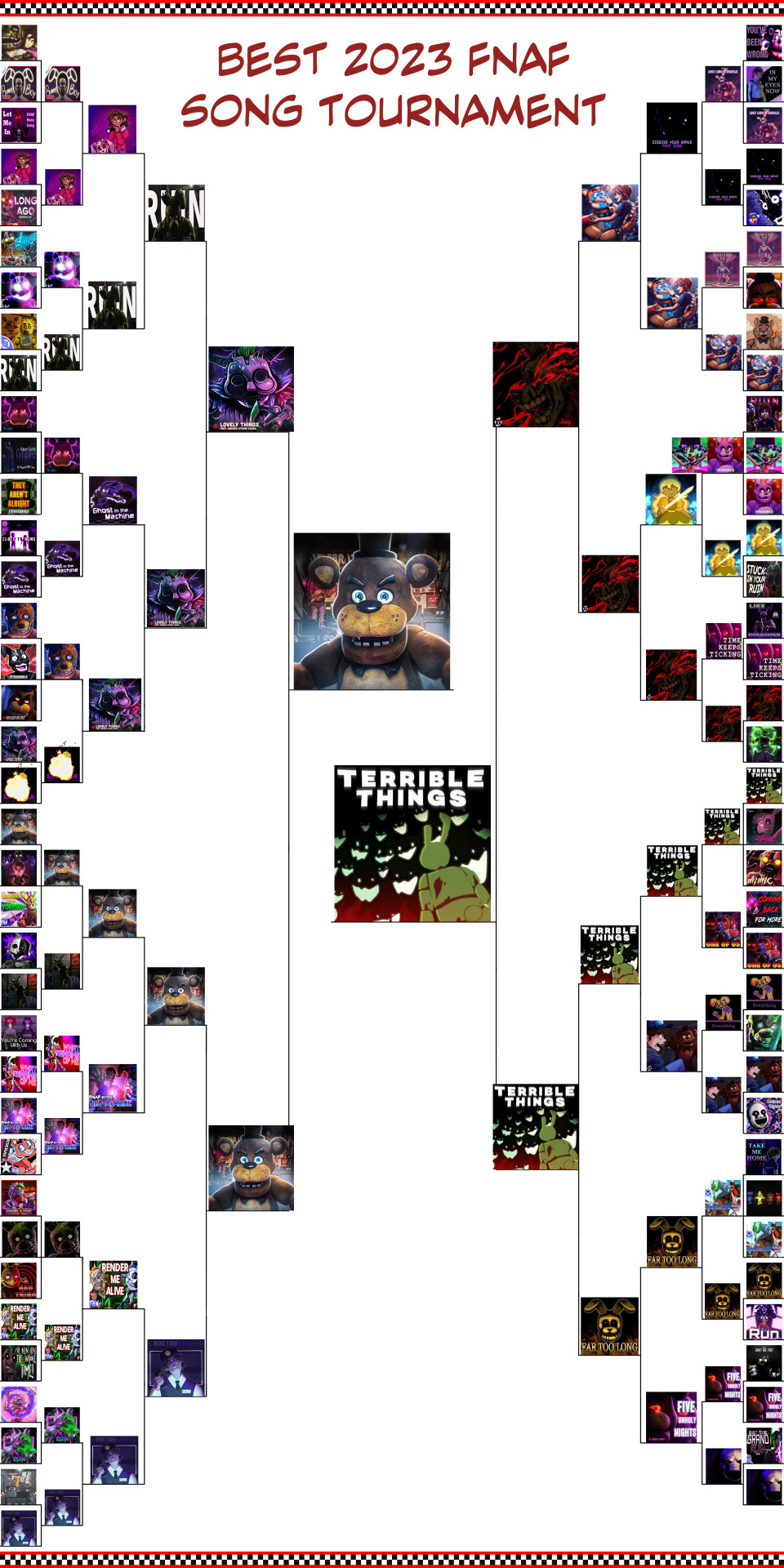
WELCOME to the Best FNAF Song Of 2023 Tournament!!!
EVERY SINGLE SONG that got nominated is included in this bracket! Here's hoping we get some fun matchups!
Polls will be linked directly under the read more!
FINALS!!!
Stuck Inside has been disqualified due to substantiated claims of grooming by Black Gryph0n. An emergency poll has replaced it with Lovely Things
PLAYLIST
NOMINATION SPREADSHEET
(in case you want to see what people said about a particular song!)
DISCORD SERVER
Round 1A
Fate (Junimations) VS. Bunny Boy (Freeced) VS. Let Me In (CoffeeLemon)
Through The Valley (EvidentlyFresh) VS. Long Ago (Green Music)
Gasoline (NerdOut!) VS. Save Me (KryFuZe)
Pictures (Kyle Allen) VS. Ruin (ChewieCatt)
Five Nights (FabvL) VS. Human-Shaped Grave (LOCKE) VS. They Aren't Alright (TryHardNinja)
Close To Home (DAGames) VS. Ghost In The Machine (Shadrow)
Behind The Mask (APAngryPiggy) VS. In The Ruins (TryHardNinja) VS. This Is The Last Night (JTMusic)
Lovely Things (JTMusic) VS. Stuck Inside (BlackGryph0n)
Back For Another Bite (JTMusic) VS. Ruined Lullaby (CG5) VS. Brought This On Yourself (TryHardNinja)
This Opportunity (Tynado) VS. Blood Runs Thicker (PARANOiD DJ)
You're Coming With Us (MonochroMenace) VS. What Remains Of Me (LongestSoloEver)
Tilt-A-Whirl (Man On The Internet) VS. Freddy You're Supposed To Be On Lockdown (MiatriSs)
Better (Nightcove The Fox) VS. Lost Souls (ChewieCatt) VS. A Bad Thing (Nightcove The Fox)
Render Me Alive (TryHardNinja) VS. I've Been Here The Whole Time (WereWING)
Make Me Whole (KryFuZe) VS. Ruin (Alpha25)
Cries Of The Missing (Eleven) VS. Graveyard Shift (Doctor Siren)
Round 1B
You've Been Wrong (Logan Pettipas) VS. In My Eyes Now (Nigthcove The Fox) VS. What Lurks In Shadows (KryFuZe)
Digging Your Grave (Lexo) VS. Mechanized And Alive (Arcadify)
Chronicles Of Bonnie - Treachery (Scraton) VS. Treat You Right (NerdOut!)
Come Play (Lydia The Bard) VS. I Found You (APAngryPiggy)
Ruin (Nightcove The Fox) VS. Afton's Empire (KryFuZe) VS. Bad Rabbit (TryHardNinja)
You're The Key (Kyle Allen) VS. Stuck In Your Ruin (Shawn Christmas)
Like A Disguise (Nightcove The Fox) VS. Time Keeps Ticking (Griffinilla)
Bury Me In Metal (Tynado) VS. Let Me Out (APAngryPiggy)
Terrible Things (Axie) VS. Ballad Of The Walking Machines (CG5) VS. The Mimic Song (Rockit Music)
Coming Back For More (DHeusta) VS. One Of Us (Nightcove The Fox)
Everything (EvidentlyFresh) VS. Connection Terminated (TheManBeHisLa)
Remnants Of Gold (Tynado) VS. Endless Nights (SubwayTacoMan)
Take Me Home (Nightcove The Fox) VS. A Silicon Soul (j-gems) VS. Hand And Eye (Man On The Internet)
Far Too Long (Nightcove The Fox) VS. Run (xXtha)
What Are You? (KryFuZe) VS. Five Unholy Nights (Cormick Murray)
Built To Be Grand (GM) VS. Your Wrath (MsBakuBeats)
Round 2
Bunny Boy (Freeced) VS. Through The Valley (EvidentlyFresh)
Save Me (KryFuZe) VS. Ruin (ChewieCatt)
Five Nights (FabvL) VS. Ghost In The Machine (Shadrow)
Behind The Mask (APAngryPiggy) VS. Stuck Inside (BlackGryph0n)
Back For Another Bite (JTMusic) VS. Blood Runs Thicker (PARANOiD DJ)
What Remains Of Me (LongestSoloEver) VS. Tilt-A-Whirl (Man On The Internet)
Lost Souls (ChewieCatt) VS. Render Me Alive (TryHardNinja)
Ruin (Alpha25) VS. Graveyard Shift (Doctor Siren)
What Lurks In Shadows (KryFuZe) VS. Digging Your Grave (Lexo)
Chronicles Of Bonnie - Treachery (Scraton) VS. I Found You (APAngryPiggy)
Afton's Empire (KryFuZe) VS. Bad Rabbit (TryHardNinja) VS. You're The Key (Kyle Allen)
Time Keeps Ticking (Griffinilla) VS. Bury Me In Metal (Tynado)
Terrible Things (Axie) VS. One Of Us (Nightcove The Fox)
Everything (EvidentlyFresh) VS. Remnants Of Gold (Tynado)
Hand And Eye (Man On The Internet) VS. Far Too Long (Nightcove The Fox)
Five Unholy Nights (Cormick Murray) VS. Your Wrath (MsBakuBeats)
Round 3
Through The Valley (EvidentlyFresh) VS. Ruin (ChewieCatt)
Ghost In The Machine (Shadrow) VS. Lovely Things (JT Music)
Back For Another Bite (JTMusic) VS. Tilt-A-Whirl (Man On The Internet)
Render Me Alive (TryHardNinja) VS. Graveyard Shift (Doctor Siren)
Digging Your Grave (Lexo) VS. I Found You (APAngryPiggy)
You're They Key (Kyle Allen) VS. Bury Me In Metal (Tynado)
Terrible Things (Axie) VS. Remnants Of Gold (Tynado)
Far Too Long (Nightcove The Fox) VS. Five Unholy Nights (Cormick Murray)
Round 4
Ruin (ChewieCatt) VS. Lovely Things (JT Music)
Back For Another Bite (JTMusic) VS. Graveyard Shift (Doctor Siren)
I Found You (APAngryPiggy) VS. Bury Me In Metal (Tynado)
Terrible Things (Axie) VS. Far Too Long (Nightcove The Fox)
Round 5
Lovely Things (JTMusic) VS. Back For Another Bite (JTMusic)
Bury Me In Metal (Tynado) VS. Terrible Things (Axie)
FINALS
Back For Another Bite (JTMusic) VS. Terrible Things (Axie)
#tournament#tournament bracket#fnaf fan music tournament#poll#polls#poll masterpost#five nights at freddy's#five nights at freddys#fnaf#2023 tournament#LETS GO
25 notes
·
View notes
Text
Character Creation Challenge, Day 6: Dawn
Believe it! (idk, i haven't watched Naruto)
The tagline of this game on Itchio is "A Shonen inspired TTRPG" and you can tell. The art is very manga inspired action shonen style, not only by the poses and action scenes but also by the character design of the characters shown.
I found this game like every game i found lately: i was bored and scrolling through itchio physical game page. I like my shonen anime, they are not my favorite genre (my favorite anime is a comedy slice-of-life one) but i still like them, it's a good time and they are fun, so i was, at least, a bit interested in this game. Now that it had its 1.0 release, it's a good time to try it.
Now, the character sheet is another excel one, found here. Still not used to it but hey, if it works, it works. So let's get to work.


Anima was granted the power of the flame unwillingly when she was little, a "tradition" of her family. Yet this flame has been consuming her slowly, making her more erratic, more violent. Fight, Break, Repeat. She was trained to control it but it is never enough. Fight, Break, Repeat. Maybe one day, she'll break the cycle. If she's willing. If she wants to.
This character is basically my take on the Orochi cursed from King of Fighters, I was set to make Iori Yagami in Dawn, so i think i managed to do it, or at least a good attempt to it.
This game reminds me of a fighting game, and sure enough, if you see the list of inspirations, Arcs System (creators of fighting games like Guilty Gear) is in there. The character creation is very flexible, you can make a lot with it, and the gameplay vibes i get reminded me weirdly of Masks, the superhero ttrpg, which i get it but mechanically is wildly different. But honestly, i would give it a shot, i would like to play Anima, or another character that fits the GM's world better. It would be fun.
#character creation#character creation challenge#charactercreationchallenge#ttrpg#dawn#dawn ttrpg#dawn the rpg
4 notes
·
View notes
Note
hi i found your page cause of your Masks art!!
imma be running a game of masks and was wondering if you have any tips
Oh hello! Very cool you're gonna run a MASKS game, it can be a lot of fun!
I'm not sure how helpful my advice will be since I'm still learning and am not sure how well I actually run the game haha, but for starters there's a whole lot of great advice on Reddit that will help with the mechanics and the structure of the game. In my opinion, the Principles section in the GM part of the core book is critical and succinct and is great advice for running ttrpgs in general.
my top advice is:
"We play to get the next issue picked up!"
Play the game like we want people to buy the next issue and not put the series down! Take chances! Make big choices! Make it interesting! Be bold!!
other things:
Theme. Establish the themes of your story early on. This will help you understand how the world and story should respond to the PCs. And make the themes interesting to you! For example, beyond the general coming-of-age story themes already built into the character arcs, I lean heavily into the concepts of fame, celebrity, and the 24-hour news cycle. And all the things that were going on in the early 2000s.
Be a Fan of the PCs. This is my favorite rule from The Principles. Make sure all your players soak this rule in. The MASKS mechanics mean characters will often make less-than-optimal decisions, so players must feel supported in their character choices. You should be a fan of the characters, and so should your players! They should want to help bring out every character's arc, not just their own.
Treating Human Life as Meaningful is what Makes Threats Real. This is another principle, but yeah, make the world's NPCs feel like they matter, and that will make the world worth protecting. Treat them as people. Give everyone Drives, not just your Villains. Mentally treating even non-villain NPCs as having Conditions can do a lot to help with characterization.
Condense. Condense your world, your NPCs, make the world feel smaller. In our game, for example, having the Protege's mentor also be the same superhero who saved the Delinquent years ago was a great decision.
Playlists. I have a bunch of different playlists for the campaign, from a big one of music of the time (our game is set in 2004) to playlists for important NPCs, to playlists I asked my players to curate for their characters. Music inspires me a bunch, a song can help create a villain for me, and I also like choosing a different "ending" song for every episode based on whatever happened.
Stories. Okay, here's the thing. I don't really care much for superhero stories. Why did I choose to run MASKS, you ask? Because of the emotion-based mechanics. That's my shit. But anyway, I don't take in much superhero media... But I do LOVE movies and television and stories in general, and I think taking in a lot of "short stories" is helpful to develop an instinct on how to pace a story, make a character or moment memorable, etc. And because MASKS has an episodic nature, this is extremely important! The sheer amount of movies I've watched has helped me a whole bunch, since they have to get the Beginning, Middle, and End done within such a short time frame.
Don't Wait. This is an instinct I've picked up from some of my favorite media. Don't wait for The big important moment. Make a lot of big important moments, and make the characters have to make a lot of important choices, and keep the momentum going. Paint yourself into a corner and then force yourself to think of ways out! It makes the story more interesting. (this may not apply to everyone, I get this kind of mindset from shows like Breaking Bad and Succession, which for your story could be too much haha)
Everyone Works. Okay, I am not a benevolent, sweet GM, I will not smile with tears in my eyes and quietly work away and accept that without complaint. no way. I make my players help me a lot. I'm gonna whine. Guys I'm doing so much work! Guys this is hard! Weeehhh! MAKE THEM HELP YOU. RUNNING A GAME IS SOOOOO MUCH WORK OH MY GOD IT'S SOOOOOO MUCH WORK!!! Ask them to take notes! Ask them to treat the world with sincerity! Ask them to make NPCs! Ask them to play NPCs! Ask them to help fill out the world! Ask them to tell you what their character wants to do next so you have extra time to consider it! Ask them to make playlists for their characters to help you figure out how to engage with them! Don't let them just show up on playday!! I'm a "you get what you give" kind of GM. You're a player too and you deserve to enjoy the game as well, and having the other players help you helps a BUNCH. PUT THEM TO WORK.
what else. uh. visuals help a lot with engagement so i subscribed to a bunch of modern battlemap patreons. i run using Foundry which lists the rules upon every roll which is great for me, someone with horrid memory. if you're lucky and favored by god, you'll have a benevolent player that will be the scribe for your sessions and log everything down so they can be referred back to (again, great for someone like me with a horrid memory). remember to give focus to the PC's out-of-costume lives as well. make NPCs in response to your PCs (superheroes, villains, touch on something of a PC in the creation process). be silly. be serious. be sincere.
i'm still figuring out how to run the game, maybe i'll have better advice on a later day, but i hope this can help some! sorry this is longwinded and more a stream of consciousness than it is succinct.
#ask biji#masks a new generation#ttrpgs#the truth is i have very little idea of what i'm doing#it's my first time running a PBTA game#but i do think the system is quite fun and fits my GM style more than say dnd#but also i'm so serious make your players work#PUT THEM TO WORK#GMING IS SOOOOOO MUCH WORK#okay maybe it doesn't have to be#but for ME it is a whole lot of work#dnd at least has a lot of parts to use#masks on the other hand is a lot of hey just make it up!!#i quite like just making things up but it is an extra mental load#so yeah PUT THEM TO WORK#also if you draw please post your art in the masks tag#my presence there must be diluted
42 notes
·
View notes
Text
Character Friction: On “Asshole Characters”, or Shitty Little Guys.
A while ago I floated a few thoughts I had about “asshole” characters in the Indy TTRPGs community. I floated these questions because I had been listening to this interview between Klaus von Hohenloe of The Dungeon Newb's Guide and The Panic Table. In particular, Klaus mentions that some games don’t allow for player friction, and in games where this is the case (cough D&D cough), it culminates in a horrible experience for all involved.
To illustrate, I’m going to talk about some experience I’ve had with my own play groups.

Art from Last Fleet, by Vicentius Matthew.
It might be shocking to hear, but I’ve played D&D once or twice. I remember being in a campaign with two players who wanted very different things from that game. Player A wanted to bring their character on a deep emotional journey, while Player B wanted to act as strategically as possible in pursuit of their character’s benefit, often to the detriment of other members of the party. My own character wanted to track down leads to a mystery that mattered to her, but not really to anyone else. This often led to frustrating moments where characters might not communicate as much information to the party as they might have otherwise, and in other cases one character’s actions could pull the entire party’s journey off-course.
The three of us all played together in a completely different game, three years later - Last Fleet. Let me tell you, the character interactions were completely flipped on their heads. Player A got a dramatic emotional arc around an NPC who was integral to the main plot. Player B got to pursue their own agenda, often in ways that worked against the efforts of other PCs. As the GM, I was given tools that actually encouraged both of these moments: both pushing Player A to wrestle with their relationship and implicating Player B as a suspicious person very early on.

A basic move from Last Fleet.
There are a number of reasons this worked in Last Fleet and not in D&D. One, Last Fleet playbooks often encourage players to keep secrets, work against the benefit of the crew, and fuck up their relationships with each-other. Two, Last Fleet has something called the Pressure mechanic. This is both a resource and a time bomb: you can mark Pressure to improve your chances of success, but hit your cap and your character has to do something to relieve their stress - and that choice is usually rather detrimental to the ship.
Finally, Last Fleet’s a different kind of story. You’re not playing heroic adventurers fighting monsters and clearing out dungeons. You’re playing the last desperate strains of humanity, fleeing an alien threat that has the power to infiltrate your fleet and resemble the ones you love most. Last Fleet is all about how a high-stress situation can lead people to making poor decisions, and, should you desire, it can also be about how people are sometimes forced to rely on each-other in order to get through a harrowing situation.
When I compare these situations, I don’t think we had bad players at the table: we just had the wrong kind of game for the story that the players wanted. I suppose I haven’t necessarily played enough D&D to say that it can’t allow for compelling, flawed characters - what I like to call “shitty little guys” - but I certainly don’t think it’s a play culture that accounts for the diversity of player goals.
More to the point, I find myself really drawn to playing flawed characters - both with them and for them. I love my over-perfectionist superhero in MASKS who lashes out when her friends don’t meet her standards. I adore my Thirsty Sword Lesbian who doesn’t know how to flirt or how to process emotions. I’m having so much fun watching play-testers pick up their various monsters in Protect the Child and demonstrate each character’s struggles when it comes to relating to a kid. I think it’s fascinating that in Changeling: the Lost 1e, a Fairest is rewarded with a discount when they use their Contracts of Reflection to spy on people that they love.
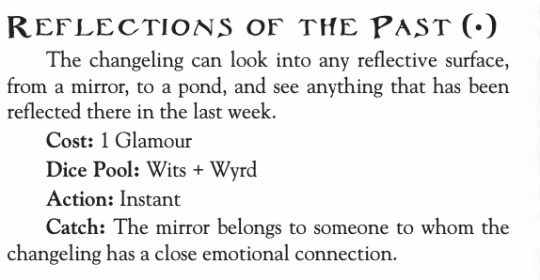
Contract of Reflections, Equinox Road Sourcebook, Changeling the Lost 1e.
I’ve personally seen the most leeway for character friction in PbtA games, like Apocalypse World, Urban Shadows, and Apocalypse Keys. When I brought up the question in the Community post, I asked folks for other examples of playing Shitty Little Guys. Their interpretations were really interesting, and far broader than my initial scope.
@nebmia mentioned that by giving your characters “unpleasant” abilities, it will incentivize them to use those abilities in unpleasant ways.
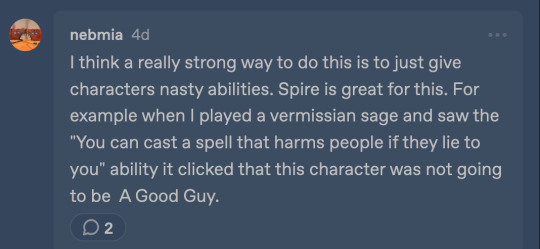
@goblincow has a lot of thoughts about creating little guys who aren’t just horrible, but are also in horrible situations - which gives license for the players to endanger their characters in the pursuit of mischief.
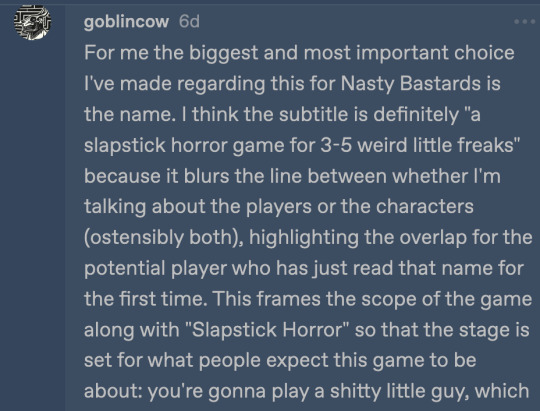
@airkseablade brought up Tenra Bansho Zero, and how it uses something called an “Emotion Matrix” to randomly determine how a player character might reaction to meeting a new person, as well as “Fates”, which are goals that each player is rewarded for playing towards, but mostly based on group consensus.
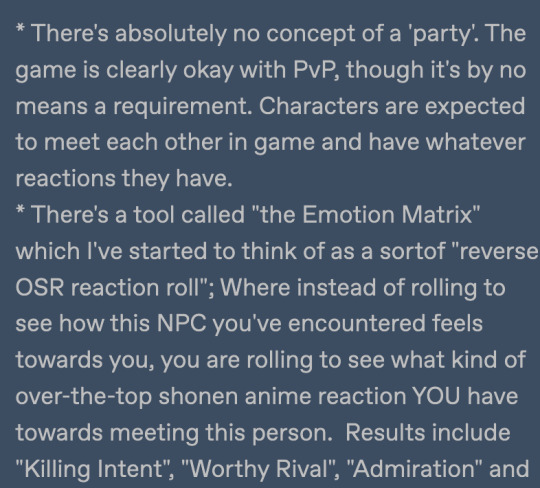
@willknightauthor talked about Wraith: (The Oblivion?), and how each archetype available to players has a part of themselves that pulls them towards darker choices.
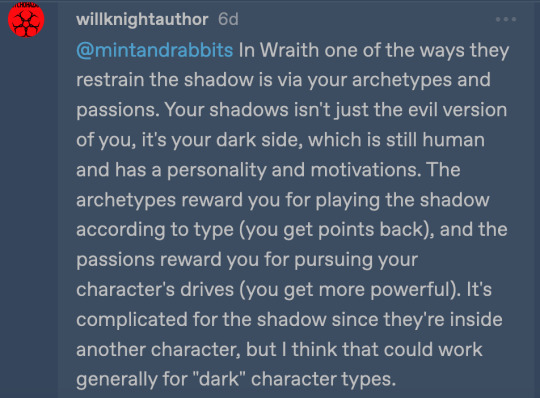
It turns out that we really like playing characters who are mean-spirited, greedy, and struggling to get what they want, and we have a lot of different ways to make that happen. It reminds me of a common piece of advice given to writers when they’re writing a novel - you want a character who’s flawed, because those flaws can be used.
In games like Trilogy or TSL, you might want those flaws because you want to see your character overcome them. In games like Mothership or Cairn, you might want those flaws because then it makes it easier to push your guys through a meat-grinder. In games like Hillfolk or Apocalypse World, you might want those flaws because you want to see just how much well-meaning or desperate characters can fuck each-other up, given the right circumstances.
So what’s the point of all this? What am I trying to get out of this?
When I hear stories about horrible players, the experience I’ve had at my tables makes me want to approach these “trouble” players with a bit of grace. Perhaps these “trouble” players simply want something that is a challenge to provide in a game like D&D, but in Mothership, Urban Shadows, Apocalypse World etc., they might find their choices welcomed and encouraged. And if you've found yourself being accused of being a "trouble" player because you like to a cause drama, perhaps these games might be more up your alley than you think!
Consider playing a game with horrible guys who suck today!
#mint speaks#indie ttrpgs#dnd#tabletop games#sometimes the experience you want is waiting for you#in another game#also thank you luka for embedding the phrase “horrible guys who suck” into my brain#mint plays games
137 notes
·
View notes
Note
Sometimes, when I psychoanalyze Jaehyun, I couldn't help but think how his possible attraction to men is not surprising. Ever since, Jaehyun already demonstrated how his father is actually the leading figure in his life, which may come as surprising because familial norms are used to having mothers as source of comfort (and from the 127 documentary, a lot of the members did not really grow up with good father figures). But from Jaehyun's stories, it is his father that he seeks comfort and guidance from. Jaehyun likes people that are assertive, mature, wise, stable, yet still comforting and gentle. I couldn't help but think how he possibly patterns the traits he look in a partner after his father (Freud, you will always be famous :D), and how Doyoung perfectly exhibited these traits.
Contrary to his image, Jaehyun is not dominant. His recent interaction with Lauv shows that. He is shy and reserved, but his natural softness and smile are enough to make it look like he is sociable. (That's why I doubt his claims of being an E in the MBTI, when he shows major signs of introversion, even Doyoung is more sociable than him and the latter is a proud ISFJ). I remember he was asked if he would like to be a leader or older member of the group and he answered he enjoyed being younger and not taking charge. His personality is chill and ebbs and flows, he prefers someone leading him instead of taking the lead, yet at the same time, gives him the space to be stubborn and be on his own occasionally. I think someone like Doyoung is really a perfect partner from him.
Orientation develops pre-birth.
Jaehyun had his granny. She coddled him a lot in childhood, and wrote letters with commentary on his dancing when he was a trainee. He talked about her a lot during EnNaNa.
I won't pretend I know for sure, but Jae started mentioning his father (and going for advice to him, playing sports) when he talked about himself as a young adult.
Regardless, the father is definitely the more openly affectionate parent. Jaehyun talked about his mother being a reserved person, and how it was a problem for him, several times.
Doyoung is not a very stable person, heh. Based on whom did you write the list of traits? Who are the other people Jaehyun likes for their personality we know of? (bedise GM, who hardly can be counted) Ten, WW and Yuta don't answer the list.
Koreans are in general shy during first meetings. And even men in their 40s can be very giggly or hesitant. Evenso, normally there is more awkwardness and "don't raise your head", than real shyness. While Jaehyun, despite years as a celebrity, has to rely on "bro" gestures to somehow mask how socially inept he is. Lauv, indeed, was a clear case. They both are of similar age, both have similar status as celebs, Jae is a fan and had motivation to give a good impression, charm and forge a friendship for future collabs. And yet Jae retrited immidiently after a hug or an eye-to-eye.
And no, Jaehyun is not an E. Koreans lie about their MBTI-s in general. Some celebs even lie about their birthdates.
This moment with Doyoung and Taemin from 2016 is good for comparison. Doyoung was awkward, but he pushed himself to do what he had to do, play along.
I think JaeHyuk (and JaeWoo, in the past especially) is good at highlighting Jae's non-assertiveness. Haechan literally can push Jae against the wall, heh. And when Jae wants to stand his ground or has his way, he does it with the help of his stuborness and defiance rather than dominance. Jaehyun can't behave in a way as to be perceived by Woo as a hyung (whose word is finite), so he opts to slight agressiveness and cold responces.
I don't know how Jae's father is, but we might see Jae emulating him (as an example most close to him) in his relatioship with Yuta. With Yuta Jaehyun is a protective figure.
I wouldn't say Jaehyun has a chill personality, lol. He is no Taeil. Jaehyun is accepting, that's different. He is very moody though, can be emotional. In 2018 or 2019 neos joked how TaeJae squabbles were their favourite show at that time.
8 notes
·
View notes
Note
if you have the time, what are your favorite ttrpgs? I'm interested in getting into the genre but dnd is kind of hard to break into. Again, you don't have to answer if this would take too much time to explain. Thank you!
So I’ve played about 35 different games, mostly one shots. I’ve had the benefit of playing with people I trust which can greatly influence game play. Below I’m going to include the full list of games with brief descriptions, but favorites first.
I definitely prefer non-traditional, narrative, and gmless games, so that will be a running theme.
Tales From the Loop has to go first because it’s the game that made me fall in love with ttrpgs. This game has Stranger Things vibes. You play a preteen in the 80s in a town where weird shit is constantly happening. This game is more on the traditional side. There’s a GM running the story, you roll for skill checks, there’s probably a specific story playing out that your gm will try to hook you on to. This game uses only 6 sided dice. There is a sequel listed below for teens in the 90s.
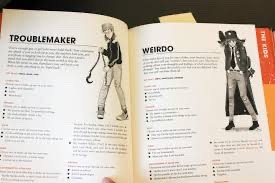
Fall of Magic is a narrative rpg with at most 3 dice rolls in the entire game. FoM is played on a beautiful, handmade map. Your characters progress through the cities on the map as you collaboratively tell the story of your journey to the birthplace of magic. Every city on the map has locations in it with a narrative prompt. Each player decides what location to visit and acts a scene at the location answering the prompt. Anything you say becomes true. There are no rolls. Nothing makes me want to write an epic fantasy more than a good game of Fall of Magic
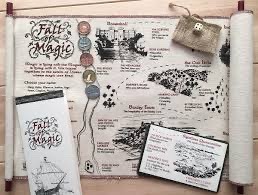
Pasión De Las Pasiones is a PBTA game, which is one of my favorite systems. In it you play a character from a long-running telenovela. I suggest only playing with a gm familiar with the genre who can do justice to the setting. There’s lots of scandal and intrigue. In fact one of the possible characters to play is the secret evil twin of any of your fellow players. PBTA gamesone are closer to traditional with dice rolls and a gm, but emphasizes the narrative more. Rolls are based on you committing to certain tropes and are boosted by narratives rather than any sort of character skills. (I also suggest checking out other PBTA games.)
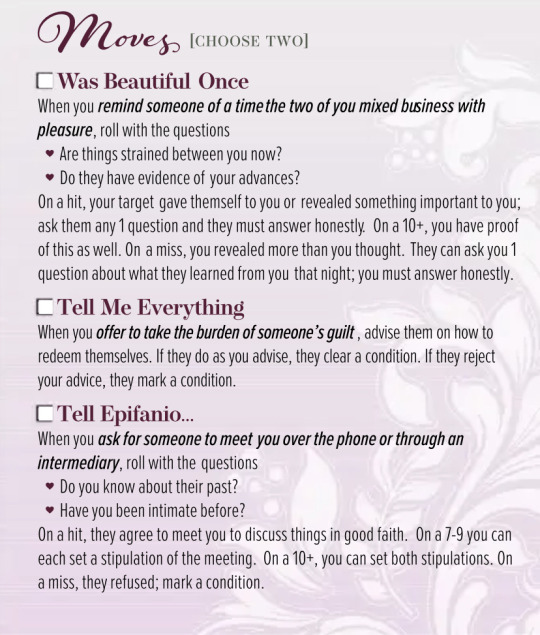
A Quiet Year is a map drawing game. All you need to play are a deck of cards, a printout of what the cards mean, and drawing materials. You tell the story of a community rebuilding after a harsh winter, answering prompts from the cards for each week of the year. As you build the village and create the story, you draw a map to show all you have done. No artistic skill is necessary. You do not play a character in this game. There is no gm. There are no dice rolls. This is the map from my last game. (I prefer to use wrapping paper for more space)
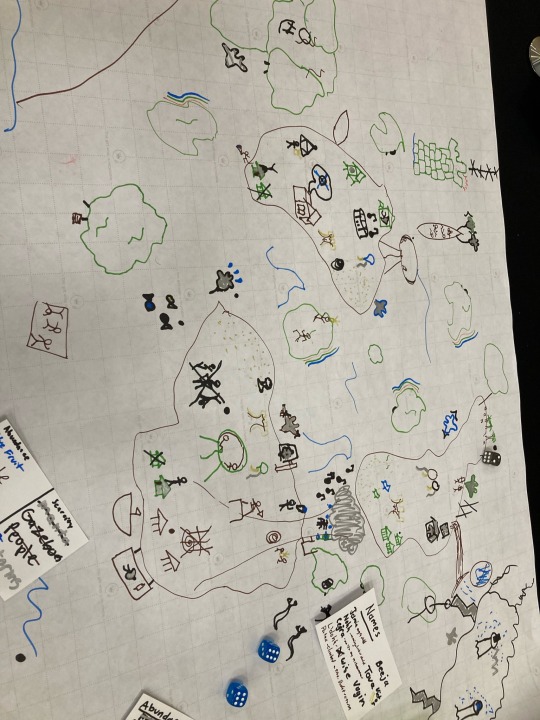
Dialect is a language building game in which you collaboratively make up new words that become completely normal to you through play. You play as members of an isolated community of any sort (lost mars colonies, online message boards, a thieves guild) which breaks down over the course of the game. You play out the evolution and eventual dissolution of your joint language. Each turn comes with a prompt for which you create a word and then play a scene. This is great as a stand-alone but I love the idea of using it as worldbuilding for a larger campaign.

I will hopefully do another post talking more about someone games tomorrow
(Warning for q slur used once below cut)
This is a list of all the games I’ve played with a short description for each. I do not recommend all of these, but feel free to ask more about any of them. I’ll talk more about some of these in future posts.
Masks (teenage super heroes. PBTA)
Paranoia (dystopian bureaucratic comedy horror)
Weave (app based multi genre. Left very little impression for me)
Tales from the loop (80s teenage horror mystery. D6 based game)
Things from the flood (90s teenage horror mystery. Sequel to above)
Descent into Midnight (map drawing game. psychic underwater entities in a community fighting an influence. PBTA.)
Dream askew (queer enclave as society falls PBTA. Book also contains a jewish companion game set in a shtetl, Dream Apart)
Rippers (dark Victorian. supernatural hunters)
Pasion de las Pasiones (telenovela the rpg. NDNM)
Fall of magic (map based, gmless, story telling game. High fantasy. I own but have not yet played their second scroll game City of Winter)
-
Fiasco (multi genre heist-gone-wrong game. Gmless. D6 based)
Inspecteres (ghostbusters-esque, bureaucratic comedy. Some mockumentary elements.)
Dnd (we all know this one)
Quiet year (map drawing, gmless game on the growth of community)
Dialect (linguistics based game telling the story of a collapse of community)
Microscope (world-building game played over the course of an era. Great for works building for a larger campaign)
Lady blackbird (single scenario game- helping a noble escape arranged marriage. Steampunk)
Lasers and feelings (Star Trek, basically. One pager. Great for new players and gms. Good system to build a home brew based on)
Castle falkenstein (steampunk+fantasy adventure)
Headspace (cyberpunk, anticorp. Emotionally intense/triggering)
-
Mouse guard (mouse fantasy adventures)
Numenara (science fantasy adventure game. Earth based, 1000 years off)
Manifest (sci-fi western)
Damn the man save the music (employees try to save their dying indie record store and achieve their personal goals. 90s)
Ryutaama (npcs travel and experience the joy of existence)
Dead Halt (a hotels AI has gone rogue. You work there. Try to survive. Horror-ish but in a campy way)
Knave (a very simplified fantasy adventure game)
Thirteenth Age (similar to dnd with a few unique interesting features. Made by creators of dnd 3&4)
Anomaly (tarot based gmless game about a sinister organization investigating supernatural anomalies)
Visigoths vs. Mall goths (conflicts and romance between the warriors who sacked Ancient Rome and 20th century spooky teens. Takes place in a mall in 1996)
-
Arcana Academy (magic school game. Don’t play with strangers because they will fall into HP tropes)
Alice is Missing (silent game played over discord or similar. A mystery is solved through texts and group chats
Worlds Without Numbers (large world fantasy adventure game. OSR. Similar in concept to dnd but with plenty of differences. More human centric)
Nahual (Mestizo shapeshifting angel hunting underdogs)
Sign (sign language building game. Deaf children develop their language collaboratively in a new school setting. Played silently.)
#ttrpg#ttrpg community#dnd#fall of Magic#tales from the loop#a quiet year#pasion de las pasiones#long post#dialect#dnd isn’t the only game#answered#lucky charms#one of the six or one of one of the sixes
34 notes
·
View notes
Text
The Forever Game, pt 2: What Gets to Be a Forever Game?
referencing this post
Let's talk about what counts as a Forever Game, shall we? Considering it's a term I saw once on a post I can no longer find and proceeded to formalize with Proper Noun Caps, it certainly can't prove to be a reductive taxonomy, can it?
As I mentioned in part 1, I think of Forever Games as being a type of game on its own - something with a certain approach to character design & progression, which is built with some assumption of long-term play. After all, I don't usually suggest Mage: The Awakening as a one-shot game.
This conception clearly isn't universal - a number of respondents brought up the fact that just about any game can be the one a table comes back to as their baseline, so long as they like it enough. And that's absolutely true - For the end user, any game can serve any purpose. Unfortunately, and with respect to the people who brought it up, this observation just isn't very useful for our purposes.
It's absolutely true that any game can be someone's forever game. But that's a feature of tabletop games as a medium - the fact is, at the end of the day all games take place inside our heads. This is why people use D&D 5th edition as a murder mystery game, or a tabletop-visual-novel; they understand that the fundamental mechanism of this art form is the limitless power of imagination, and are comfortable using the same rules framework every time to build whatever narrative they like, regardless of whether or not better-tailored alternatives exist.
If we want to get on the same page about Forever Games, we need to look at something concrete - like on-paper design of games themselves. That in mind, let me put forth some qualities that a Forever Game might have:
Almost certainly a trad game. While games like Wanderhome exist, the vast majority of titles I'd list as forever game candidates have a GM and probably use at least two denominations of dice.
A multi-faceted character framework. In other words, a race/class system is better suited for a Forever Game than simple Playbooks, generally speaking. This is for replayability's sake. Some folks play wizards all the time, every time - but if you've just spent five years as Slagnarr the Axinator, it might be nice to start over as a healer for the next go round.
A customizable progression track. The more a game allows you to make a capital-B-Build, the better. This is part & parcel with the above point, re: replayability, but it serves another purpose - embodying your character concept. Imagination is well and good, but there's something special about having a class feature that supports the way you want to play your character. It makes them feel more real.
At least one game mode that involves intricate mechanical interactions. The classic version of this is a grid combat system - but a crunchy exploration system or involved crafting mechanic are also good examples of this. The more rich and interesting a game's... well, game elements are, the better the game will hold up over time. Note that I don't say complex, but rich. There's a reason GURPS light is more popular than the full ruleset. Games tend to last longer when they give more of the table something to be doing at any given time, minimizing dead zones in play.
Little in the way of social mechanics. Hear me out on this - for a lot of tables, the ability to get together with friends, put on a mask, and goof off without fear of social repercussion is a huge draw. Having to do the same kinds of rules reference for politicking that you use for mosnter slaying doesn't facilitate the fantasy; it hinders freedom of play. You want the chance to fail your Will save because it creates interesting drama. The idea that you might be punished for shamelessly flirting with the King while his consort is Right There ruins the fun. A table's forever game is going to be something that lets them play casually. I don't think this is a controversial opinion; the idea of a "beer and pretzels" game is older than I am, and anyone who's been in a long-term game with friends knows how loosey-goosey things can get. I think that facilitating jokes has a solid correlation to facilitating coming back to the game.
This isn't really working towards anything. Really, I just wanted to take the opportunity of my own vagueness to elaborate a bit on what exactly I mean when I say "forever game," so if I decide to keep poking the hornet's nest, we can at least agree on whether I'm using a stick or a branch.
11 notes
·
View notes
Note
stumbled across some of your posts about a code lyoko ttrpg
i am interested please tell me more 😭
ive been wanting to run code lyoko dnd for so long but i dont have the smarts to change dnd to make it feel code lyoko
Hey there! I'm super excited that someone's interested in this because it's such a passion project of mine haha, I'm sorry in advance if this answer is more than you bargained for!
To give you the rundown, I ran a very brief and experimental dnd 5e hack for Code Lyoko a couple of years ago for some friends. It was a lot of fun, but the system was SO badly Frankenstein'ed that we ran into a lot of technical issues, especially regarding the Lyoko/reality split and how it effected different builds. The old guide for that hack can be found here for free, but please take note that it is very informal and poorly optimized!
Recently though, I've been experimenting with non-dnd systems and building my own tabletop games, which is where Warriors of Xanadu comes into play. (This might get lengthy so feel free to skip to the TLDR.)
Warriors of Xanadu is a code-lyoko/garage-kids inspired system that I'm working on myself with the help of a few more experienced friends. It's built off of the Apocalypse World framework (basically a 2d6 system–if you've played Monster of the Week, Masks, or Avatar: Legends, think something like that) specifically designed to work well with the world and story CL provides. That means all the gameplay mechanics are inherently relevant to running code-lyoko-inspired adventures and there's no extra work to be done on your part. It's also a lot easier to teach/learn than something like DnD. (Even the character sheets are designed to be accessible so players could technically make their character with just their printed-off sheets and no additional resources! Much easier than dnd.)
Each non-GM player plays as a "Hero" and chooses a unique combination of a playbook (centered around academic character tropes like cool kid, geek, class clown, etc.) and a class sheet (how they appear on "Xanadu," with options like rogue, mage, warrior, etc.). Then, In-game, heroes go through episodic challenges where they encounter problems in reality caused by "the Virus," and must transport themselves to Xanadu to combat it. There's also a handful of original mechanics relating to social/academic rapport, corruption from the supercomputer, etc. The health/harm system and combat is inspired by Apocalypse World and Monster of the Week, and is meant to inspire a more survival/horror element than what something like dnd would provide. (Essentially the goal is not to engage in and "win" lengthy combat encounters, but to stay alive and usually avoid enemies when possible.)
I feel it's also important to note that it's not 1:1 Code Lyoko; it's very transformative and a handful of ideas are heavily abstracted to be more fun in a ttrpg setting. It's open-ended and customizable enough that you could technically run an unrelated story with it. That also means that there's some fun surprises for folks familiar with Code Lyoko, though, and you could still run something close-to-canon if you wanted.
The first draft of WoX is about 60-70% completed, I just need to finish the GM-heavy parts of the manual, finish some of the moves, and actually put together fillable playbooks/class sheets. I'm hoping to have it completed and ready to playtest by the end of the summer, but that's a loose deadline. Once I've done some playtesting and gotten feedback from others, I'll probably release the first public version on drivethru rpg and/or itch.io as a free or PWYW sorta deal.
TLDR; Warriors of Xanadu is a powered-by-the-apocalypse style trrpg system I'm working on. It's made from the ground up to support a Code Lyoko inspired campaign. I'm almost done with it but still have some work to do!
If you're comfy coming off of anon, I'd be happy to make note of you and send you the playtest version when I'm done with it, or answer any additional questions! (Same goes for anyone else reading this!)
#code lyoko#garage kids#nyklos is typing#wox ttrpg#sorry this is a lot I just love talking shop about ttrpgs and I never have a chance to tell people about WoX
21 notes
·
View notes